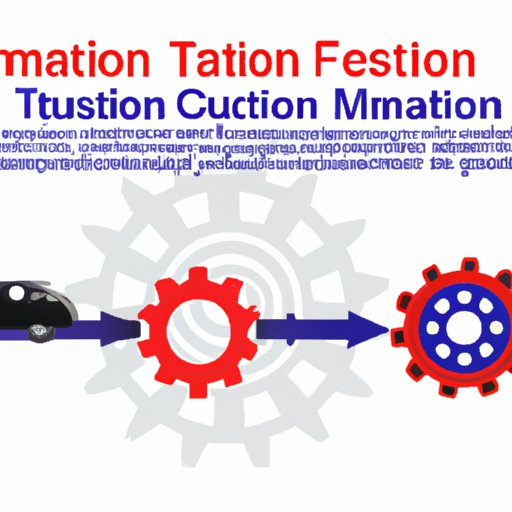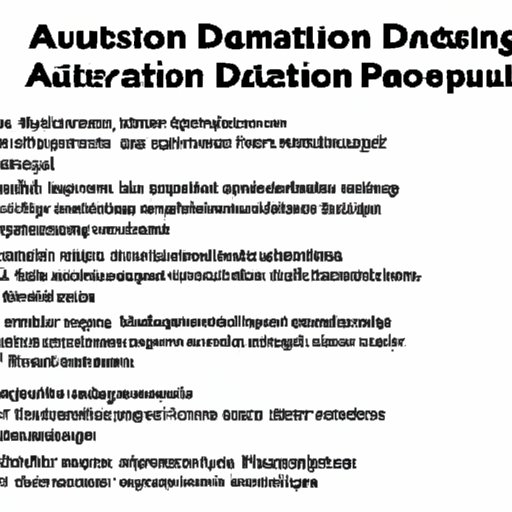Introduction
An automatic transmission is a type of gearbox that automatically changes the gear ratio between the engine and the drive wheels based on the vehicle’s speed and load. This allows the driver to focus on steering and accelerating without having to manually shift gears.
An automatic transmission consists of several major components, including a planetary gear set, hydraulic control system, torque converter, valve body, and electronic control unit (ECU). The ECU monitors the engine’s RPM, throttle position, and vehicle speed, and sends signals to the hydraulic control system to adjust gear ratios accordingly.
Exploring the Different Types of Automated Transmissions
There are several types of automated transmission available, each with its own unique advantages and disadvantages.
CVT (Continuously Variable Transmission)
A continuously variable transmission (CVT) uses two pulleys connected by an infinitely adjustable belt. The pulleys are connected to the engine and the drivetrain, and as the belt moves along them, it changes the gear ratio. This allows for seamless acceleration and improved fuel economy.
DSG (Direct Shift Gearbox)
A direct shift gearbox (DSG) is a type of automated manual transmission. It combines elements of both manual and automatic transmissions, using a clutch to shift gears instead of a traditional gear selector. The computer then selects the appropriate gear based on the driver’s input.
Dual-Clutch Transmissions
Dual-clutch transmissions (DCTs) use two clutches to shift gears. One clutch controls the odd-numbered gears, while the other controls the even-numbered gears. This allows for faster shifts and smoother transitions between gears.

How Automated Transmissions Improve Fuel Efficiency
Automated transmissions allow for improved fuel efficiency in several ways.
The Role of Torque Converters
Torque converters are used to transfer power from the engine to the transmission. In automated transmissions, torque converters are designed to be more efficient than those used in manual transmissions. This helps reduce fuel consumption.
Gear Ratios
The gear ratios in automated transmissions are optimized for maximum fuel efficiency. This helps the engine operate at its most efficient level, reducing fuel consumption.
Overdrive
In an automated transmission, overdrive is used to reduce engine speed when cruising, resulting in improved fuel economy.

The Benefits and Drawbacks of Automated Transmissions
Automated transmissions offer several advantages, but they also have some drawbacks.
Pros
- Improved fuel efficiency
- Faster shifting
- Less wear and tear on the vehicle
- Reduced driver fatigue
Cons
- Higher initial cost
- More complicated repairs
- Less control over gear selection
Comparison of Manual vs. Automated Transmissions
Manual and automated transmissions have their own pros and cons. Here is a comparison of the two types:
Cost
Manual transmissions typically cost less than automated transmissions. However, the cost difference depends on the make and model of the vehicle.
Maintenance
Manual transmissions require more frequent maintenance than automated transmissions. They also tend to need more frequent repairs due to the higher wear and tear on the clutch.
Performance
Manual transmissions allow for more precise control of the vehicle, while automated transmissions offer smoother acceleration and improved fuel efficiency.

Common Problems with Automated Transmissions and How to Fix Them
Automated transmissions can experience a variety of problems, ranging from minor issues to major mechanical failures. Here are some of the most common problems and how to fix them:
Slipping Gears
If your vehicle is experiencing slipping gears, it could be due to low transmission fluid, a faulty solenoid, or worn-out internal components. To fix this problem, check the fluid level, replace any worn-out parts, and have the solenoid checked and replaced if necessary.
Leaks
Leaks are one of the most common problems with automated transmissions. If you notice any leaks, it could be due to a cracked seal or gasket, a loose or damaged hose, or a faulty component. To fix this problem, you will need to inspect the transmission and repair or replace any defective parts.
Erratic Shifting
If your vehicle is experiencing erratic shifting, it could be due to low transmission fluid, a faulty sensor, or a worn-out internal component. To fix this problem, check the fluid level, replace any worn-out parts, and have the sensors checked and replaced if necessary.
Conclusion
Automated transmissions offer several advantages, such as improved fuel efficiency and faster shifting. However, they also have some drawbacks, such as higher initial cost and more complicated repairs. It is important to understand the pros and cons of automated transmissions before making a purchase decision. Additionally, it is important to be aware of the common problems that can occur with automated transmissions and how to fix them.
(Note: Is this article not meeting your expectations? Do you have knowledge or insights to share? Unlock new opportunities and expand your reach by joining our authors team. Click Registration to join us and share your expertise with our readers.)
